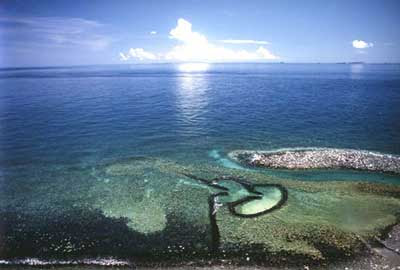

The structure pictured above is the Twin Heart Stone Weir on the island of Cimei, in the Penghu archipelago of Taiwan. There are hundreds of such weirs on these islands; the one pictured is the most famous because of the shape of the structure.
Fishing weirs have been used since prehistory in locations all around the world. In Europe they were traditionally constructed of wooden posts and wattle.
In the UK the traditional form was one or more rock weirs constructed in tidal races with a small gap that could be blocked by wattle fences when the tide turned to flow out again. Surviving examples, but no longer in use, can be seen in the Menai Strait. Because they were so effective they reduced inshore fish stocks and in 1861 Parliament banned their use except where they could be shown to have been in use prior to the Magna Carta.In North America, native americans traditionally used wooden weirs to trap salmon in rivers and tidal estuaries.
Credit to Arbroath for the heads-up on the subject.
A similar fishing setup that has been banned many places is gillnets. I have seen first hand the unbelievable effectiveness of "passive fishing." I grew up fishing on a lake in rural Ontario that had an Ojibwa reservation on it. The Ojibwa had long used gillnetting which is a passive net that snags fish in the holes of the net to catch walleye.
ReplyDeleteGrowing up "one at a time" fishing with a rod and reel on that lake I almost never caught walleye and neither did anyone in my family. Literally the year after gillnetting was banned I started to catch tons of them. The wild part about it is that the Ojibwa had been gillnetting (seems complex right?) for long before the first europeans came to Ontario.
Fishing weirs, gill nets, and the like always make me stunned at the resourcefulness and cleverness of prehistoric and semi nomadic people.